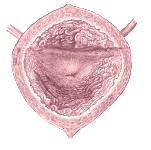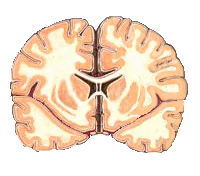Human organs
This glossary provides a comprehensive alphabetical list of human organs along with their associated systems, functions, and visual references.
A[edit | edit source]
- Adrenal glands – Located above the kidneys, these glands produce hormones such as adrenaline and cortisol as part of the endocrine system.
- Anal canal – The final section of the digestive system through which waste exits the body.
- Arteries – Blood vessels that carry oxygenated blood away from the heart to the rest of the body.
B[edit | edit source]
- Bladder – A hollow organ in the urinary system that stores urine before excretion.
- Bone marrow – Found in the interior of bones, it produces blood cells.
- Brain – The central organ of the nervous system responsible for thought, memory, emotion, and other bodily functions.
C[edit | edit source]
- Capillaries – Tiny blood vessels that facilitate the exchange of oxygen, nutrients, and waste products between blood and tissues.
- Cervix – The lower part of the uterus connecting to the vagina in the female reproductive system.
D[edit | edit source]
- Duodenum – The first section of the small intestine, where most digestion begins.
E[edit | edit source]
F[edit | edit source]
- Fallopian tubes – Tubes in the female reproductive system that transport eggs from the ovaries to the uterus.
G[edit | edit source]
- Gallbladder – A small organ beneath the liver that stores and releases bile.
- Ganglia – Clusters of nerve cells in the peripheral nervous system.
- Heart – The central organ of the circulatory system, pumping blood throughout the body.
H[edit | edit source]
- Hypothalamus – A region of the brain regulating hormones, temperature, and hunger.
I[edit | edit source]
- Ileum – The final section of the small intestine involved in nutrient absorption.
- Intestine – Includes the small intestine and large intestine for digestion and nutrient absorption.
J[edit | edit source]
- Jejunum – The middle section of the small intestine, where the majority of nutrient absorption occurs.
K[edit | edit source]
- Kidneys – Bean-shaped organs in the urinary system that filter blood and produce urine.
L[edit | edit source]
- Large intestine – Includes sections such as the cecum, colon, and rectum, involved in water absorption and waste elimination.
- Larynx – The voice box, part of the respiratory system responsible for sound production.
- Liver – A vital organ involved in metabolism, detoxification, and bile production.
M[edit | edit source]
- Mammary glands – Specialized glands in the integumentary system that produce milk.
- Mesentery – A tissue fold anchoring the intestines to the abdominal wall and supplying them with blood.
N[edit | edit source]
- Nasal cavity – The upper part of the respiratory system, filtering and humidifying air.
O[edit | edit source]
- Ovaries – Organs in the female reproductive system producing eggs and hormones like estrogen and progesterone.
P[edit | edit source]
- Pharynx – Part of both the digestive and respiratory systems, connecting the mouth and nasal cavity to the esophagus and trachea.
R[edit | edit source]
- Rectum – The final section of the large intestine that stores feces before elimination.
- Respiratory system – Includes organs like the lungs, trachea, and larynx.
S[edit | edit source]
- Skin – The largest organ of the integumentary system, providing protection and temperature regulation.
- Small intestine – Primary site of digestion and nutrient absorption, comprising the duodenum, jejunum, and ileum.
- Stomach – A muscular organ in the digestive system breaking down food with acid and enzymes.
T[edit | edit source]
- Thymus – Part of the lymphatic system, playing a role in immune system development.
- Thyroid gland – Produces hormones regulating metabolism.
U[edit | edit source]
- Uterus – A hollow organ in the female reproductive system where a fertilized egg develops into a fetus.
Human organ images[edit | edit source]
See also[edit | edit source]
- Terminologia Anatomica
- List of systems of the human body
- List of distinct cell types in the adult human body
- List of skeletal muscles of the human body
- Gene Wiki
Search WikiMD
Ad.Tired of being Overweight? Try W8MD's physician weight loss program.
Semaglutide (Ozempic / Wegovy and Tirzepatide (Mounjaro / Zepbound) available.
Advertise on WikiMD
|
WikiMD's Wellness Encyclopedia |
| Let Food Be Thy Medicine Medicine Thy Food - Hippocrates |
Translate this page: - East Asian
中文,
日本,
한국어,
South Asian
हिन्दी,
தமிழ்,
తెలుగు,
Urdu,
ಕನ್ನಡ,
Southeast Asian
Indonesian,
Vietnamese,
Thai,
မြန်မာဘာသာ,
বাংলা
European
español,
Deutsch,
français,
Greek,
português do Brasil,
polski,
română,
русский,
Nederlands,
norsk,
svenska,
suomi,
Italian
Middle Eastern & African
عربى,
Turkish,
Persian,
Hebrew,
Afrikaans,
isiZulu,
Kiswahili,
Other
Bulgarian,
Hungarian,
Czech,
Swedish,
മലയാളം,
मराठी,
ਪੰਜਾਬੀ,
ગુજરાતી,
Portuguese,
Ukrainian
Medical Disclaimer: WikiMD is not a substitute for professional medical advice. The information on WikiMD is provided as an information resource only, may be incorrect, outdated or misleading, and is not to be used or relied on for any diagnostic or treatment purposes. Please consult your health care provider before making any healthcare decisions or for guidance about a specific medical condition. WikiMD expressly disclaims responsibility, and shall have no liability, for any damages, loss, injury, or liability whatsoever suffered as a result of your reliance on the information contained in this site. By visiting this site you agree to the foregoing terms and conditions, which may from time to time be changed or supplemented by WikiMD. If you do not agree to the foregoing terms and conditions, you should not enter or use this site. See full disclaimer.
Credits:Most images are courtesy of Wikimedia commons, and templates Wikipedia, licensed under CC BY SA or similar.
Contributors: Prab R. Tumpati, MD























